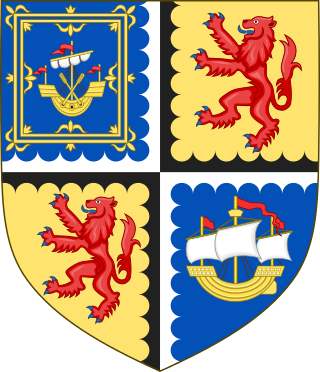The Earle of Southerland his host converyning spedelie, went on forward to pursue Clangun, according to promise. Bot meitting first, by chance, with Wm. Macky (the brother of Houcheon Macky), accompanied with divers of his cuntriemen of Strathnaver, who had even then taken and careid away James Mack-Rory his cattel out of Corrikean Loch in the Diri-Meanigh (James Mack-Rory being then the Earle of Southerland's depender), they rescued and brought back the booty and cattell. They chased William Macky and the Strathnaver men all that day, and killed one of the principalls of the Clangun in Strathnaver, called Angus-Roy, with sundrie others of William Macky his company. This wes called Claw-tom-Richi, (that is, the day of the hather bush). About the evening, they followed them, in hote chace, even to the merches and bounds of Catteynes, wher the Clangun had assembled, heiring that the inhabitants of Catteynes wer gathered together, and wer up in armes, and had taken up ther cattell. [4]
In this meantyme, William Macky, with the Strathnaver men, joyned with the Clangun, (whom they met in the hilles by chance); they promised to die and live together, and to participat of eithers fortunes, good or bad. Heirvpon, they perceave the Earle of Catteynes his host in sight of them, which wes conducted by Henrie Sinclair, the Laird of Dun his brother. Then they goe to consultation among themselves whether they suld feight against the Catteynes men, fresh and in breath, attending them, or turn aganest the Southerland men, who were wearied with ther labor the day preceiding. William Macky his opinion wes to invade the Southerland men, alreadie tyred with feighting. Bot the Clangun did choyse rather to hazard against the Catteynes men, which they did, without fear or delay, being far inferior in number. Yit they had in mynd, that nothing wes befor them bot enemies, the deip and bottomles ocean behind them; no place of retrait; no suretie bot valor and victory; so haveing the advantage of the hill, the set upon the enemy with a resolute courage. The Catteynes men came short with ther first flight of arrowes; by the contrarie, the Clangun spared ther shot until they came hard to the enemy, which then they bestowed among them with great advantage. In end, by the speciall help and assistance of the Almightie God, (in whose hands are the hearts of men, and the events of things) the Clangun overthrew the Catteynes men at Aldgown, upon the borders of Catteynes, the yeir of God 1586, and killed seaven score of ther most resolute men, with ther captane, Henrie Sincler, cousin to the Earle of Catteynes, and uncle to Houcheon and William Mckay. The Catteynes host had been all destroyed, had not the darknes of the night favored their flight, withholding the victors from the following chase. William Macky wes sore for the slaughter of his uncle Henry Sinclair, whom he knew not to be their till he was slain; bot afterward in the chase William Macky spared no man. The Southerland men knowing nothing of Clangun, had lost the sight of the Strathnaver men whilst they had them in chase amongst those hills, immediatlie befor this skirmish at Ald-gowne, and so had retired into ther owne countrey to repose themselves with the booty they had recovered; wherby they understood nothing of this skirmish until it wes finished. [4]
This disaster justlie befell the Earle of Catteynes, becaus, that since this overthrow, he hath oppinlie confessed to divers men, that it wes never his intention to pursue the Clangun at that tyme; bot his purpose and policie wes, that they might be hotely and eagerlie pursued, and then he wold releive them from that imminent danger, therby to mak them the more beholding to him and his posteritie in all tyme cumming. Bot the Almightie God did measure him rightlie, and turned his fraud and subtile policie to his own shame, and the destruction of divers of his cuntriemen. Presntlie after the skirmish at Ald-Gowne, the Earle of Catteynes (being careid with a spriite of revenge and furie against the Clangun), hanged John Mack-ean-Mack-rob, chiftane of the Clangun, in Catteynes, whom he had keiped and deteyned in captivity a good whyle, haveing, befor this tyme, trained him into Girngo to speak with him. [4]
Houcheon Macky wes then in Catteynes with Earle George, whose father sister he had mareid. But the inhabitants of Catteynes understanding that his brother, William Macky, wes with the Clangun at the conflict of Ald-Gown, they sought for Houcheon to slay him; wherupon he wes forced, in all hast, to flie secreitlie into Strathnaver, therby to eschew their present furie. Thus thie fell out some variance betuen the inhabitants of Catteynes and Strathnaver for assisting the Clangun; so that, in a maner, as soon as the Southerland men had neir ended ther troubles with Catteynes, and drew to some setleing for a short space, the Strathnaver men, assisted by the Clangun, (as iff ordained to revenge the Southerland men's wrongs one upon another), began to assault the Sinclairs, and the inhabitants of Catteynes, with the lyk afflictions, which I doe ommit to relate particularlie, as apperteyning litle to my subject. [4]









